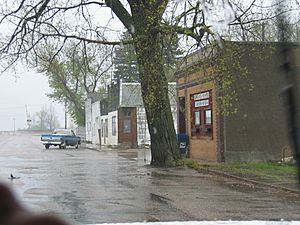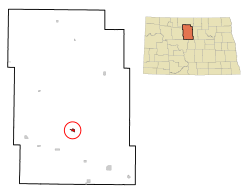Karlsruhe, North Dakota facts for kids
Quick facts for kids
Karlsruhe, North Dakota
|
|
|---|---|

A view of Karlsruhe
|
|

Location of Karlsruhe, North Dakota
|
|
| Country | United States |
| State | North Dakota |
| County | McHenry |
| Founded | 1912 |
| Area | |
| • Total | 0.75 sq mi (1.94 km2) |
| • Land | 0.75 sq mi (1.94 km2) |
| • Water | 0.00 sq mi (0.00 km2) |
| Elevation | 1,542 ft (470 m) |
| Population
(2020)
|
|
| • Total | 87 |
| • Estimate
(2022)
|
85 |
| • Density | 116.00/sq mi (44.77/km2) |
| Time zone | UTC-6 (Central (CST)) |
| • Summer (DST) | UTC-5 (CDT) |
| ZIP code |
58744
|
| Area code(s) | 701 |
| FIPS code | 38-41380 |
| GNIS feature ID | 1036102 |
Karlsruhe (pronounced KARLSS-roo) is a small city in McHenry County, North Dakota, United States. In 2020, about 87 people lived there. Karlsruhe was started in 1912.
A special place nearby is the Old Saints Peter and Paul Cemetery, Wrought-Iron Cross Site. It is listed on the National Register of Historic Places. The Sts. Peter and Paul Catholic Church in Karlsruhe has art by a famous artist named Count Berthold von Imhoff. Karlsruhe is also part of the Minot micropolitan area, which is a group of towns around the city of Minot.
Contents
History of Karlsruhe
Karlsruhe was named after a city in Germany. The first people to settle here were Germans from Russia. They moved to the northern American prairie lands in the late 1800s. These early settlers and their families are buried in the St. Peter and Paul cemetery.
When the town was new, many German traditions were common. Over time, the town became more American. Now, very few of those old traditions are still practiced. The number of people living in Karlsruhe has slowly gone down over the years.
Geography and Climate
Karlsruhe covers about 0.75 square miles (1.94 square kilometers). All of this area is land.
Understanding Karlsruhe's Climate
The weather in Karlsruhe changes a lot between seasons. Summers are warm to hot, and sometimes humid. Winters are very cold, sometimes extremely cold. This type of weather is called a humid continental climate.
McHenry County, where Karlsruhe is located, has more natural disasters than the average for North Dakota. The most common natural events are floods, storms, and heavy snow.
Population Changes
| Historical population | |||
|---|---|---|---|
| Census | Pop. | %± | |
| 1930 | 258 | — | |
| 1940 | 289 | 12.0% | |
| 1950 | 282 | −2.4% | |
| 1960 | 221 | −21.6% | |
| 1970 | 172 | −22.2% | |
| 1980 | 164 | −4.7% | |
| 1990 | 143 | −12.8% | |
| 2000 | 119 | −16.8% | |
| 2010 | 82 | −31.1% | |
| 2020 | 87 | 6.1% | |
| 2022 (est.) | 85 | 3.7% | |
| U.S. Decennial Census 2020 Census |
|||
People in Karlsruhe (2010 Census)
In 2010, there were 82 people living in Karlsruhe. They lived in 36 homes, and 25 of these were families. The city had about 109 people per square mile. There were 61 housing units in total. All the people living in Karlsruhe at that time were White.
About 22% of the homes had children under 18. Most homes (58%) were married couples living together. A small number of homes had a single female or male parent. About 30% of homes were not families.
About 22% of all homes had just one person living there. A small number (5.6%) had someone living alone who was 65 or older. On average, there were 2.28 people per home and 2.72 people per family.
The average age of people in Karlsruhe was 49.3 years. About 20% of residents were under 18. Most people (48.8%) were between 45 and 64 years old. About 12% were 65 or older. More males lived in the city (56.1%) than females (43.9%).
Transportation
Karlsruhe was once located along the main railway line of the Great Northern Railway. Today, this railway line is part of the BNSF Railway.
See also
 In Spanish: Karlsruhe (Dakota del Norte) para niños
In Spanish: Karlsruhe (Dakota del Norte) para niños

